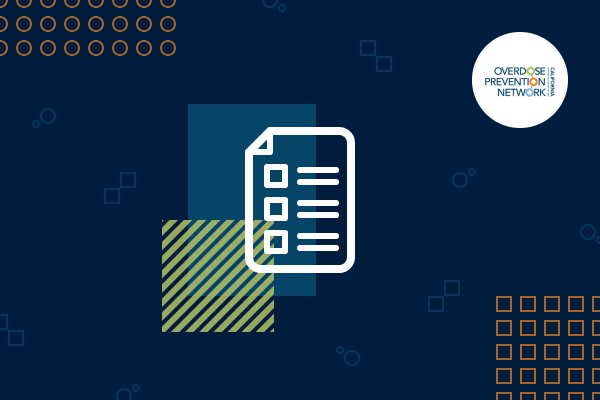
Resource Library
Toolkits, guides, and other resources vetted by experts in overdose prevention.
Filter by category and tags, or search by keyword (ex. COVID-19, harm reduction).
Well Connected Worksheet
Connections are powerful. They're assets - like money in the bank or social capital --to help us meet our goals of preventing death and disability from opioids. Mapping these assets and creating opportunities for them to contribute to your cause will expand engagement and impact. Use this worksheet to determine who your connections are, who you would like to connect with, and what connections might be missing. Make an action plan to connect with folks that could increase your social capital.
Connections Map
Connections are powerful. They're assets - like money in the bank or social capital --to help us meet our goals of preventing death and disability from opioids. Use this worksheet to figure out where your current connections are within the community, and where you are lacking. Think about connections that may help you sustain your efforts. You may not know the individuals within those groups you would like to make a connection with, but be as specific as possible where you can.
Measurement Plan Template
It is often said that what gets measured gets done. Having a measurement plan will help your coalition use data in a strategic and actionable way, including when to adjust your strategies. It will also help you tell a compelling story to your partners, funders and community. This tool provides instructions on how to create a clear plan across multiple areas of your coalition's work.
Overcoming Data-Sharing Challenges in the Opioid Epidemic
This paper is national in scope and reviews recent changes to the Part 2 regulations. The paper analyzes how Part 2 applies to primary care practices that seek to expand access to SUD treatment, and how providers in different parts of the country are navigating these rules. While focusing on care for opioid use disorder, the paper is applicable to all SUD care.
Utilizing the CDPH Opioid Safety Dashboard
When looking at the news, we often see numbers for the opioid epidemic, but do those numbers represent where you live? How can you communicate, measure and track key opioid safety indicators for your community? This infographic goes over the key elements of using the California Opioid Overdose Surveillance Dashboard, created by the California Department of Public Health.
Worth a Thousand Words: How to Display Health Data
Organizations with access to health data face difficult decisions about how best to visualize these data for clarity, storytelling, and impact. This presentation serves as a guide to select the best visualization options for your data, and explains how to get started on the path to better data presentation.
SafeRx Santa Cruz Infographic 2017
We hear a lot about the opioid epidemic in the news, but not so much about how we are going to stop it. SafeRx Santa Cruz County has been working in collaboration with doctors, pharmacists, and other community members on preventative measures.
Lessons Learned in Communicating with Data
Learn more about how to communicate with data from subject matter expert Andy Krackov. This fact sheet goes through Andy's ten tips on using data to tell stories, providing resources for each key competency.
Pharmacy Access to Sterile Injection Supplies for People Who Inject Drugs
There can be a lot of pushback in communities when it comes to syringe services. This article about how pharmacies can expand over-the-counter sterile injection supplies to prevent the spread of infection, especially during COVID-19.
How To Tell a Story With Your Data
Use this resource sheet to learn strategies for telling a story with your data, along with seeing real life examples, instructional materials and other data related resources.
Marin County Letter to Pharmacists
Opioid prescribing in Marin has decreased 48 percent since 2014, when safe prescribing was made a local public health priority. Read this news release to learn more.
National Roadmap on State-Level Efforts to End the Nation’s Drug Overdose Epidemic
This document was originally released in 2019 as a guide to help policymakers end the opioid epidemic. This document has now been expanded to include best practices and action items regarding COVID-19 and racial inequities.
Jail-Based MAT: Promising Practices, Guidelines, and Resources for the Field
Historically, it has not been the responsibility of the sheriff s and jail administrators to be primary providers of substance use disorder treatments. But with thousands of Americans dying every week from drug overdoses and those recently released from jail among the most defenseless, the situation has changed - sheriffs have taken on the challenge.
Use of Medication-Assisted Treatment for Opioid Use Disorder in Criminal Justice Settings
This guide focuses on using medication-assisted treatment for opioid use disorder in jails and prisons, and during the reentry process when justice-involved persons return to the community. It provides an overview of policies and evidence-based practices that reduce the risk of overdose and relapse.
Spirit of Harm Reduction: A Toolkit for Communities of Faith Facing Overdose
This toolkit explains how faith communities can contribute to harm reduction efforts within their communities in order to change principles, practices, and policies.
Clinical Tools for Primary Care Providers
This webpage provides tools for primary care providers to help carry out the complex task of balancing pain management with the potential risks that prescription opioids pose.



















